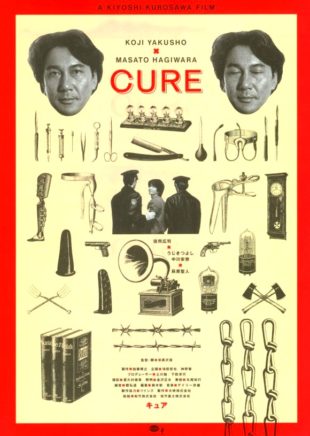 The artful and disturbing CURE was the breakout film by Japan’s Kiyoshi Kurosawa, and is still arguably his finest work. Prior to making CURE in 1998, Kurosawa (no relation to Akira) was a prolific director of Japanese B-pictures for over a decade. After CURE’S release Kurosawa made several important genre films like CHARISMA (1999), SÉANCE (1999) and PULSE (2001). None, however, came close to replicating the haunting power of CURE.
The artful and disturbing CURE was the breakout film by Japan’s Kiyoshi Kurosawa, and is still arguably his finest work. Prior to making CURE in 1998, Kurosawa (no relation to Akira) was a prolific director of Japanese B-pictures for over a decade. After CURE’S release Kurosawa made several important genre films like CHARISMA (1999), SÉANCE (1999) and PULSE (2001). None, however, came close to replicating the haunting power of CURE.
One night a businessman inexplicably kills a prostitute, leaving an X slashed across the corpse’s neck. Takabe, a detective, investigates the case, but can’t uncover any coherent reason for the murder.
The following day a strange young man is discovered wandering around a beach by a young schoolteacher. The mystery man, who identifies himself as Mamiya, doesn’t know where or who he is. Yet he has an evident talent for hypnosis, and hypnotizes the schoolteacher with a flickering lighter flame. The following day the teacher slices up his wife. Takabe questions him but once again can’t get any concrete answers.
Mamiya is picked up by cops and, finding himself alone with a policeman, again utilizes his hypnotic talents. The cop later shoots one of his fellows in the head. Once again Takabe questions the killer, and this time learns of the hypnosis.
Mamiya again utilizes his talents, this time on a woman doctor examining him. We learn a bit of his modus operandi in this scene: Mamiya has no personality of his own and so hypnotically delves into those of others, in the process subtly brining out peoples’ latent psychoses. In this case he learns the woman doctor is a frustrated surgeon; after being hypnotized she methodically slices up a man’s face in a public restroom.
Mamiya is apprehended shortly thereafter and interrogated by Takabe. The latter is easily wound up by Mamiya, and dangerously so—returning home, Takabe hallucinates his wife’s corpse hanging in his kitchen, even though she’s still alive and well. Clearly he’s falling under Mamiya’s influence, especially when he seems to kill his wife with a steak knife—but the operative word here is seems, as Takabe’s reality is steadily dissolving.
In CURE Kiyoshi Kurosawa demonstrates a mastery of tone and filmmaking know-how that’s impressive, and appropriate to the subject matter. It’s the overall calmness of the film that makes it so unnerving. Visualized largely through precisely composed wide shots with a rich multi-layered soundtrack (listen for a creepy electronic undertone that plays under certain scenes), the film never loses its cool regardless of the awfulness of the violent acts depicted onscreen.
This befits the themes of mesmerism and hypnosis. CURE has a style that is in its own way quite hypnotic, rendering the proceedings all the more disturbing with the suggestion that, contrary to what most hypnotists claim, anyone is capable of being coerced into murder. Terrific performances by Kurosawa regular Koji Yakusho and Tsuyoshi Ujiki complete this peerlessly unsettling glimpse into the darker corners of the human psyche.
Mention must also be made of Kurosawa’s penchant for teasing ambiguity. In this film the “explanations” are scant, with much about the killer’s motives and methods left ambiguous, and a puzzling neither-here-nor-there ending. Whether this constitutes a flaw I’m not sure, but Kurosawa’s enigmas make for an alternately fascinating and maddening viewing experience.
Vital Statistics
CURE
Daiei Co.
Director: Kiyoshi Kurosawa
Producers: Tsutomu Tsuchikawa, Atsuyuki Shimoda
Screenplay: Kiyoshi Kurosawa
Cinematography: Tokusyo Kikumura
Editing: Kan Suzuki
Cast: Koji Yakusho, Tsuyoshi Ujiki, Anna Nakagawa, Masato Hagiwara, Yoriko Doguchi, Yukijiro Hotaru, Denden, Ren Ohsugi, Masahiro Toda
